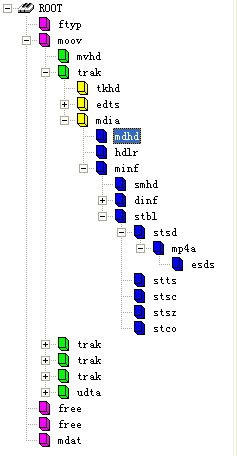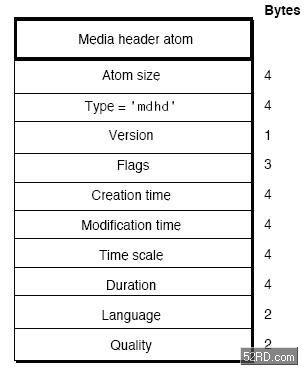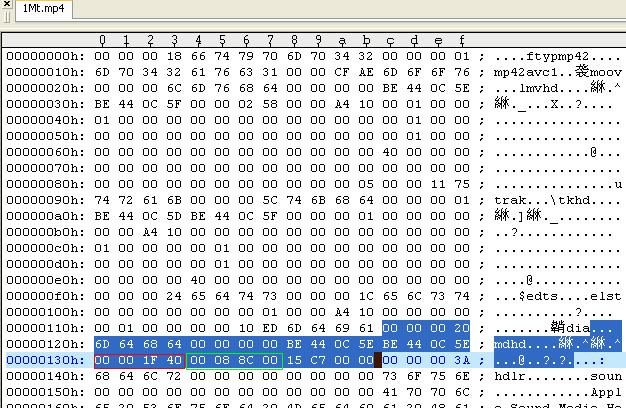Android MP4取得播放时长的方法
Android中取得mp4文件播放时长的处理位于MPEG4Extractor::parseChunk函数中,是从mdhd box中取得timescale和duration后,通过公式播放时长 = duration / timescale 计算出播放时长的,单位为秒(s)。
Android与一般从mvhd box中取得mp4播放时长的处理不一样。(参考:计算MP4文件播放时长的方法)
mdhd位于"moov/trak/mdia/" box下面,如下图所示,是一个audio track展开后显示的box结构。(mp4 chunk在apple的规范中称作atom,在标准mp4中称为box。)
下面先介绍下mdhd box的相关知识:
1.Media Atoms - MDIA
Mediaatoms定义了track的媒体类型和sample数据,例如音频或视频,描述sample数据的mediahandler component,mediatimescale and track duration以及media-and-track-specific信息,例如音量和图形模式。它也可以包含一个引用,指明媒体数据存储在另一个文件中。也可以包含一个sampletable atoms,指明sampledescription, duration, and byte offset from the data reference foreach media sample.
Mediaatom的类型是'mdia'。它是一个容器atom,必须包含一个mediaheader atom ('mdhd'),一个handlerreference ('hdlr'),一个媒体信息引用('minf')和用户数据atom('udta').
| 字段 |
长度(字节) |
描述 |
| 尺寸 |
4 |
这个atom的字节数 |
| 类型 |
4 |
Edts |
2.Media Header Atoms - MDHD
Mediaheader atom定义了媒体的特性,例如timescale和duration。它的类型是'mdhd'.
各个字段的解释:
| 字段 |
长度(字节) |
描述 |
| 尺寸 |
4 |
这个atom的字节数 |
| 类型 |
4 |
mdhd |
| 版本 |
1 |
这个atom的版本 |
| 标志 |
3 |
这里为0 |
| 生成时间 |
4 |
Movieatom的起始时间。基准时间是1904-1-10:00 AM |
| 修订时间 |
4 |
Movieatom的修订时间。基准时间是1904-1-10:00 AM |
| Time scale |
4 |
A time valuethat indicates the time scale for this media—that is, the numberof time units that pass per second in its time coordinate system. |
| Duration |
4 |
The durationof this media in units of its time scale. |
| 语言 |
2 |
媒体的语言码 |
| 质量 |
2 |
媒体的回放质量???怎样生成此质量,什么是参照点 |
还是以上一篇(计算MP4文件播放时长的方法)中时长为70秒的1Mt.mp4文件为例:
(1)Audiotrack的值
蓝色阴影部分是audio track的mdhd box,长度为十六进制20,即十进制32个字节。
其中红色框内四个字节位于mdhd box的第21-24字节,为timescale的值,十六进制为00 00 1F 40,转换为十进制的8000。
绿色框内内四个字节位于mdhd box的第25-28字节,为duration的值,十六进制为00 08 8C 00,对应十进制的560128。
所以根据公式:播放时长 = duration / timescale = 560128 / 8000 = 70.016秒,即音频时长约为70秒。
(2)Videotrack的值
与audio track的mdhd box类似,可以计算出video track的播放时长。
3.下面是取得时长的代码处理,在MPEG4Extractor::parseChunk函数函数中
case FOURCC('m', 'd', 'h', 'd'): // mdhd box
{
if (chunk_data_size < 4) {
return ERROR_MALFORMED;
}
uint8_t version;
if (mDataSource->readAt(
data_offset, &version, sizeof(version))
< (ssize_t)sizeof(version)) {
return ERROR_IO;
}
off_t timescale_offset;
// 取得timescale相对与mvhd初始位置的偏移量
if (version == 1) {
timescale_offset = data_offset + 4 + 16;
} else if (version == 0) {
timescale_offset = data_offset + 4 + 8;
} else {
return ERROR_IO;
}
// 读取timescale值
uint32_t timescale;
if (mDataSource->readAt(
timescale_offset, ×cale, sizeof(timescale))
< (ssize_t)sizeof(timescale)) {
return ERROR_IO;
}
mLastTrack->timescale = ntohl(timescale);
// 读取duration时长值,version版本1的读取方便与其他版本有区别,需要分开读
int64_t duration;
if (version == 1) {
if (mDataSource->readAt(
timescale_offset + 4, &duration, sizeof(duration))
< (ssize_t)sizeof(duration)) {
return ERROR_IO;
}
duration = ntoh64(duration);
} else {
int32_t duration32;
if (mDataSource->readAt(
timescale_offset + 4, &duration32, sizeof(duration32))
< (ssize_t)sizeof(duration32)) {
return ERROR_IO;
}
duration = ntohl(duration32);
}
mLastTrack->meta->setInt64(
kKeyDuration, (duration * 1000000) / mLastTrack->timescale); // 播放时长 = duraion / timescale
*offset += chunk_size;
break;
}



